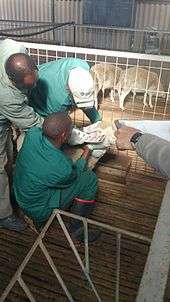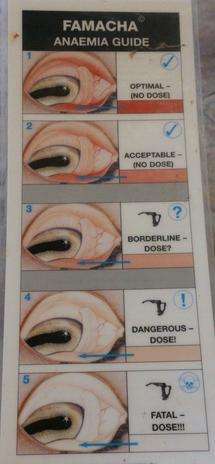FAMACHA

FAMACHA (FAffa MAlan CHArt) is a method whereby only certain sheep or goats in a flock are selected for treatment against wireworm (also known as barbers pole worm, Haemonchus contortus). Sheep are selected for treatment based on the degree of anaemia they are displaying in their mucous membranes. In turn, the degree of anaemia is assessed through a colour guided chart.
Background
The FAMACHA method of selective treatment was developed by three South African researchers (Drs Francois Malan, Gareth Bath and Jan van Wyk) against the backdrop of major anthelmintic resistance in South Africa.[1][2][3] However, the method has since been implemented successfully in various locations around the world.[4]
The main aim of the method is to maintain a sufficient susceptible wireworm population (‘refugia’) on the pasture. By only dosing those sheep in critical need of treatment, selection for wireworms resistant against treatment is retarded, while at the same time the farmer can monitor and cull those sheep with a poor natural resistance against these worms.
Procedure
Anaemia (as observed in the mucous membrane of the eye) is assessed via a colour guided chart: a sheep with a score of 1 having a pink-red mucous membrane colour and not requiring treatment for haemonchosis; whereas a sheep with a score of 5 has white mucous membranes, requiring immediate dosing for haemonchosis and probably intensive medical treatment.

References
- ↑ Bath, G.F.; Malan, F.S; van Wyk, J.A. (1996). "'The "FAMACHA" ovine anaemia guide to assist with the control of haemonchosis". Proceedings of the 7th Annual Congress of the Livestock Health and Production Group of the South African Veterinary Association. Port Elizabeth, South Africa.
- ↑ Van Wyk, J.A.; Bath (2002). "The FAMACHA© system for managing haemonchosis in sheep and goats by clinically identifying individual animals for treatment". Veterinary Research. 33: 509–529. doi:10.1051/vetres:2002036.
- ↑ Van Wyk, J.A.; Malan, F.S.; Randles, J.L. (1997). "How long before resistance makes it impossible to control some field strains of Haemonchus contortus in South Africa with any of the modern anthelmintics?". Veterinary Parasitology. 70: 111–122. doi:10.1016/s0304-4017(96)01147-8.
- ↑ Besier, R.B (2008). "Targeted treatment strategies for sustainable worm control in small ruminants". Tropical Biomedicine. 25 (1 (suppl)): 9–17.